
Photo from wikipedia
Oxygen isotope ratios of garnet provide well-established means to investigate crustal fluid histories. Traditionally, δ18O values from skarn garnets have been used to track the hydrothermal evolution of an individual… Click to show full abstract
Oxygen isotope ratios of garnet provide well-established means to investigate crustal fluid histories. Traditionally, δ18O values from skarn garnets have been used to track the hydrothermal evolution of an individual skarn body through time. We, however, use garnet from 14 skarns from the Jurassic (ca. 175 to ca. 148 Ma) Cordilleran margin arc (southwestern United States) to provide regional tectonic context to arc magmatism and hydrothermal activity. We document arc-wide garnet δ18O variability of ~19‰ (–8.9‰ to +10.3‰, n = 159), providing a record of contrasting meteoric fluid ingress between northern (Sierra Nevada) and southern (Mojave Desert) arc segments. Strongly negative garnet δ18O values (≤–3‰) are limited to the Mojave Desert arc segment and can only form in the presence of meteoric fluid, requiring shallow formation in subaerial crust. When combined with U-Pb garnet ages, the δ18O data provide a minimum radiometric age of local subaerial arc emergence and temporal constraint on the migration of the Jurassic paleoshoreline in the Mojave Desert section of the arc.
Journal Title: Geology
Year Published: 2021
Link to full text (if available)
Share on Social Media: Sign Up to like & get
recommendations!